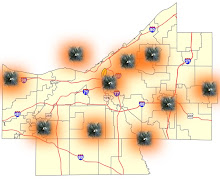As we discuss the design of Tim Hagan’s + Jimmy Dimora’s Monument (aka the Cuyahoga County Administration Complex), we must consider what we are wishing to make monumental. Not much if we think about it. Let us explain.
Seats of government are usually inculcated with values + beliefs that define a nation, state, of even a city. Think of the United States Capitol, a democratic edifice fronting a democratic green expanse of the Mall. Think of the many state capitol buildings around the country, each hosting, projecting, or alluding to the essences of their states, like Nebraska’s populist Capitol Building, or more recently, the proposed State of Alaska Capitol. Even think of Cleveland’s City Hall, an important built presence within Tom L. Johnson’s + Daniel Burnham’s Group Plan.
There is pride, blood, sweat, and toil embedded within each of these physical manifestations of democratic government. Soldiers and sailors died in service of the United States and their home states, at least during the Civil War—markers, names, and remembrances can be located within Capitols or on the grounds. City pride resides in the halls of a City Hall building, usually ornamented with murals, statues, etc. which showcase the ethnicities, diversities, and beliefs of a community. These buildings possess meaning and are part of a national, state, or local collective memory that transcends generations.
Do we possess any loyalty or pride that concerns our County? Hardly. A county building will merely contain the excesses of a Democratic patronage system and nepotism. A County Building will remind us of employees who leave work at 4 PM, a bureaucracy that sucks tax dollars away from over-taxed citizens, and an impotent, gluttonous government infrastructure that is continuing to allow residents to leave the county at a clip of 10,000 people a year.
So the new complex should have been programmed to accomplish something, like offer a new paradigm of urbanism, display techniques of the proper manner of the restoration of mid-century modernism, or the re-use of existing urban buildings. There should be a reason to make something “monumental,” other than the presence of an unnecessarily massive bureaucracy.
Subscribe to:
Post Comments (Atom)





No comments:
Post a Comment